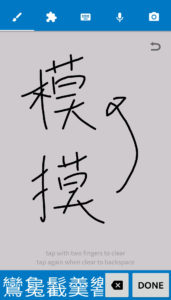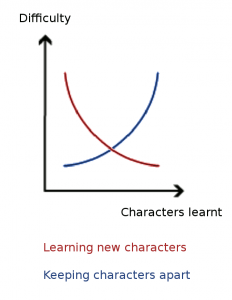 To be able to read and write Chinese, you need to learn several thousand characters. For beginners, this looks daunting, because learning the first handful of characters is hard. You might struggle with remembering how to write basic components, leading to situations where you simply don’t know what to write at all.
To be able to read and write Chinese, you need to learn several thousand characters. For beginners, this looks daunting, because learning the first handful of characters is hard. You might struggle with remembering how to write basic components, leading to situations where you simply don’t know what to write at all.
This type of problem becomes rarer the more characters you learn, however. Advanced learners and native speakers will seldom have no clue about how to write a character they have learnt, although it does happen occasionally (how do you write the tì in dǎ pēntì for example?)
I’ve written about the real challenge when learning Chinese characters before, but in this article, I want to look at a method for dealing with the problem of an ever-increasing number of characters to keep distinct from each other.
Tune in to the Hacking Chinese Podcast to listen to this article:
Available on Apple Podcasts, Google Podcast, Overcast, Spotify and many more!
Dealing with Chinese characters you keep mixing up
While spaced repetition software, such as Skritter or Anki, can help you learn characters effectively, you need a more strategic approach to deal with mixed up pairs, triplets or groups of characters.
Hammering away at your flashcard app will only give you temporary reprieve if you don’t also pair it with a deeper insight into what caused the error in the first place. With enough flashcards, this can keep you occupied forever.
Since this article deals with the problem of confusing and mixing up characters with each other, it’s most useful for intermediate and advanced learners. If you’re a beginner, I suggest you head over to my introduction for learning Chinese characters instead:
Trace your errors to the source
To figure out confusing groups of characters, you need to see them all at once, or make some concentrated effort comparing them to each other. If you only study them individually, you risk perpetuating the error by failing to notice key differences.
Please note that the method I recommend should only be used to sort out characters you have already learnt, not to learn new characters. Learning words that are closely related in meaning or sound at the same time makes them much more likely to be confused later. Learn characters organically based on what you read, not by artificially trying to find similar characters.
You can use the below method at any point where you fail to write a character. It might be overkill to use it every time, so save it for those times when you have a feeling you’re confusing two or more characters. On the other hand, tracing your error might sometimes only take a few seconds, even if the process might look elaborate here:
- Note the correct character, or what you should have written but failed to recall. For example, maybe the character you were supposed to write is 摸 (mō) “to stroke; to touch”.
 Also note the character you wrote instead. This relies on using pen and paper, or an app that allows you to write characters uninterrupted (so you can finish writing the whole character and only then reveal the answer; check out “rawest squigs” if you’re using Skritter). For example, you forgot how to write 摸 and wrote 模 instead.
Also note the character you wrote instead. This relies on using pen and paper, or an app that allows you to write characters uninterrupted (so you can finish writing the whole character and only then reveal the answer; check out “rawest squigs” if you’re using Skritter). For example, you forgot how to write 摸 and wrote 模 instead.- Look up the character you wrote instead. The easiest way to do this is to use the handwriting input in apps like Pleco or Hanping, which will allow you to write anything you want. You will then find that 模 is pronounced mú or mó and means “pattern; to copy” and not “to stroke; to touch” as you thought. Once you see this, you’ll probably sigh and say to yourself “how stupid of me, of course the character that means touch has a hand in it”.
- Save your notes somewhere where you can easily access them later when you’re in front of a computer or have some time to spare to dig into the problem properly. I actually just take screenshots in Pleco to do this (see the picture on the right).
When you look up the character you incorrectly wrote (模 in the example above), you might encounter one of several situations:
- The character is very rare or does not exist. This means that you’re probably not confusing the characters, you just remember how to write the character incorrectly or guessed. You added a component that shouldn’t be there or or maybe combined components that aren’t combined in that way. Note that since there are so many variants of characters, most combinations exist somewhere, but if they are beyond your target vocabulary range, there’s no practical difference between “very rare” and “does not exist”. Real example from my studying: When trying to write 讧, I accidentally wrote 䜤, which is a decent guess, but which is so rare that most dictionaries do not list it at all. So, this was not a case of my mixing up these two characters; I just forgot how to write 讧.
- The character exists and is used in modern Chinese, but you haven’t learnt it yet. This is the situation I warned about above: don’t learn this character just because it’s there. You’re likely to make the confusion worse. Ignore it for now and learn it later. It might also be hard to figure out if the character is common enough to warrant learning right now, so don’t habitually create flashcards just because you can. It matters which characters you learn!
- The character exists and overlaps with the other character. This means that even though you’re wrong, you are also at least partly right. For example, if you write 工做 instead of 工作, you are kind of right, because 做 and 作 have overlapping meanings. Of course, in this particular case, you’re still wrong, but in other cases, it might be hard to know this for sure. One recent example for me is 借此 (see relevant tweet for context). Should it be 借此 or maybe 籍此? This is not obvious and requires some research. (In simplified Chinese, it should probably be 借此, but both would be okay, whereas in traditional Chinese, 籍此 is preferred.) You might need help to figure these things out.
- The characters don’t overlap, but you have learnt both. This is the case where tracing your errors makes the most sense and the whole reason for using this method. The example from above with 模 and 摸 might serve as a good example here. Both characters exist and are in common use. You need to be able to remember which one is which. They don’t overlap in meaning, so this a clear case when you confused two characters that share some components, but don’t mean the same thing. Seeing them next to each other will help you never make that mistake again!
You have now successfully identified a pair of characters that you get mixed up. Sometimes, there are more than two characters involved. For example, I found it tricky to keep track of all the characters pronounced fu with the same phonetic component (甫): 敷、缚、辅、傅 and so on. If you have your own pairs or groups of tricky characters, why don’t you share them in a comment below?
Bringing order to chaos
 Now that you have identified two or more characters that you frequently get mixed up, you need to do something about the problem.
Now that you have identified two or more characters that you frequently get mixed up, you need to do something about the problem.
This is essentially the same thing as killing leeches, i.e. dealing with any tricky vocabulary you keep getting wrong over and over, but this time you also need to care about the relationship (differences and similarities between the characters).
Here are a couple of things you can try (the links lead to separate articles with suggested resources for that very activity):
- Analyse the composition of the characters – Which are the components? Which functions do they have in that particular character? You probably know this already, but make sure you got it right. Maybe you’ve missed something important.
- Put the character in context – Instead of trying to learn the difference between 做 and 作 as single characters, study them in relevant contexts. If you know a bunch of words with these characters already, draw a little mind map. Add a few to your flashcard app for extra reinforcement.
- Highlight the difference between the characters – The reason to do this ought to be obvious since the whole point is to keep the characters distinct. The similarities probably don’t need more attention, because those were what made you mix these characters up in the first place. My article about near-synonyms might also be interesting!
This is probably one of the best usages for mnemonics and memory techniques. You need to remember something specific and it could be something you don’t have to be able to recall often or quickly, but you still need to know it. Mnemonics for character learning goes beyond the scope of this article, so I’ll merely point you in the right direction if you want to know more:
Conclusion
Learning characters at an intermediate and advanced level is different from learning characters as a beginner. Keeping similar characters distinct becomes a real problem, and if you’re not careful, a pair or group of characters can generate a lot of extra work and frustration. The solution is to trace your errors to figure out why you get the characters wrong and then deal decisively with them!
I’m doing this for several groups of characters at the moment, some of which have been mentioned in the article already. What characters are you confusing? Why are you confusing them? Post a comment below! By doing so, you’re also more likely to do your research, collect your thoughts and commit them to memory.
See more examples of how I deal with error tracing in my own learning here:
https://www.hackingchinese.com/7-mistakes-i-made-when-writing-chinese-characters-and-what-i-learnt-from-them/

11 comments
I was confusing 俩 and 辆 a few weeks ago. They were both relatively new words I’d come across while reading and added to my flashcards only a few weeks prior. I knew which pronunciation corresponded with which meaning, but I kept confusing the 汉字 to meaning. Once I stopped and realised that the person radical corresponded to the person meaning and the car radical corresponded to the car meaning, I was right and haven’t confused them again. It’s all about noticing the differences. I had a similar experience with 伸 and 仙 the other day too. Once I noticed my mistake, I checked both characters and noticed the differences.
I doubt your Chinese level is advanced if you still confuse 俩 and 辆
I am Chinese but didn’t know “部首” is “radical” in English until I read your message. “Person radical” means “人字旁(部首)”. I DO learn something from this site. Thanks!
How important is the rule of not learning the character’s meaning. 摸 is a good example, because until now it was not on my list. I know 漠 (沙漠 desert ), 模 (模型 modell), 镆 (the element meaning of Moscovium, not really learned, but the construction principle from 莫 as the first character in 莫斯科 Moskow).
It’s HSK5 and Hanzicraft’s 1365th most frequent character, not on my current todo list, but not far away. So I tend to put it on my (still not drawn) mo-莫-characters diagram.
Two characters I currently mixed (or learned at the same time) are 传 and 转. They were on the list with 专 too, so I draw a 专-Diagram with the total set hanzicraft gave me,专传转砖抟, with 砖抟 not to learn, but to distinguish.
I think drawing such diagrams is great for sorting out issues, which is what you’re doing. These will help you sort out which is which and create good mnemonics for them.
The risk I’m talking about is if you learn several words meaning roughly the same thing at the same time, or several sounds that sound almost the same. The principle “what fires together, wires together” has some truth to it, so if you learn similar words together, they will be harder to distinguish later (there’s plenty of empirical evidence for this; check e.g. Paul Nation’s Learning Vocabulary in another Language). While I haven’t seen any study about this, think about mixing up left and right, up and down, words for fruit and so on.
So, learning one extra character this way is not really a problem, I wrote that bit because I don’t want people to start drawing diagrams like you describe for learning new characters, like: “Today I’m going to learn ten characters that contain 莫”. But that’s not what you propose, so I’d say it’s certainly okay to learn 摸. It’s also quite common!
Hi! I am a Chinese from Hong Kong but don’t speak Putonghua (Mandarin). I always think that it’s kinda a mission impossible for someone to learn to write Chinese after grown up. Most of the Chinese I know don’t even have a fair command of Chinese writing. They are unable to express themselves freely in writing. Very often, they write the wrong words with similar pronunciation.
Hi! It’s time consuming, but certainly not impossible. 🙂
Some learners of Chinese can not only write both Traditional and Simplified Characters, but also type on a computer with Cangjie Input and Pinyin Input. That’s really impressive. I use only Cangjie Input and cannot master Pinyin Input as I am not a native Putonghua speaker. I’m planning to take a class on Putonghua pronunciation in a couple months. Hopefully, the COVID-19 pandemic will settle down by then. The class focuses on the four tones of Putonghua among which we Hongkongers often can’t tell the difference.
I considered learning Cangjie a few years ago, because I wanted a method that would reinforce my knowledge of characters while also speeding up typing, but I never got around to do it. I’m not that scared of new keyboard layouts, considering that I’ve learnt to type with the Dvorak keyboard layout and have used it for more than a decade now. I can type Qwerty reasonably fast, too, so adding one more shouldn’t be all that hard. Obviously, Cangjie is completely different from just switching letters around, and I didn’t consider it worthwhile back then. I do occasionally feel an urge to learn it, but I’ve been able to fight it so far. 😀
I watched a TV program many years ago. It had some people do some tests and found the method of typing Chinese characters on a computer with the fastest speed was Wubi Input (Five Strokes Input). Pinyin was the second. Cangjie was way behind the two. I guess it is still true at present. I think Cangjie is kinda another mission impossible for a non-native Chinese speaker to learn. You need to have the image or construction of the Chinese character in your mind before you can type it on a computer with Cangjie Input. Cangjie Input is mostly, if not only, used in the Traditional Chinese community — Taiwan and Hong Kong. Many people did try to learn Cangjie Input but failed. Those who find Cangjie Input easy to learn probably break Chinese characters in a way similar to that of the inventor of it. When looking up a Chinese word in a dictionary, we need to break it into components. If you break Chinese characters in a way very different to that of the inventor of Cangjie Input, there is fat chance of you mastering it.
I was under the impression that Wubi as designed mainly for simplified Chinese, but now that I actually read the article on Wikipedia, it says it’s for both, so I think I was wrong. I type both traditional and simplified, but used to type almost only traditional in grad school, so that’s why I considered Cangjie back then. I’ll need to look into Wubi more, I think. Probably still not worth it, but might be interesting. 🙂